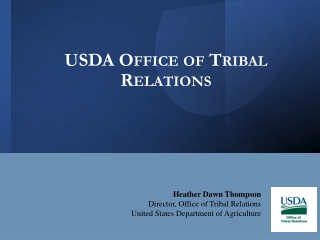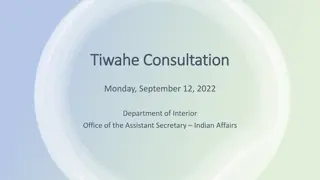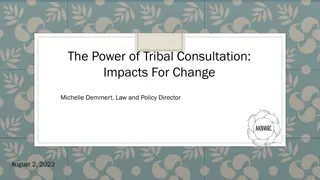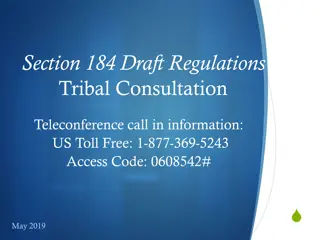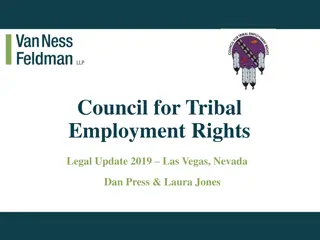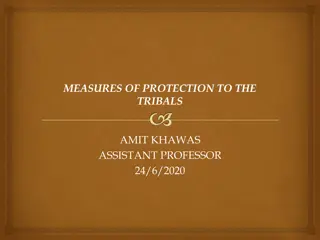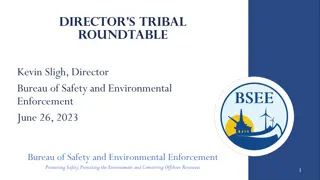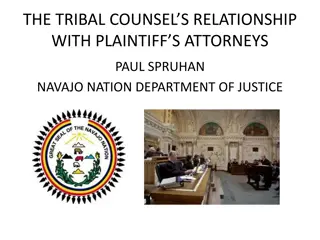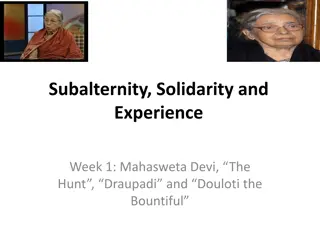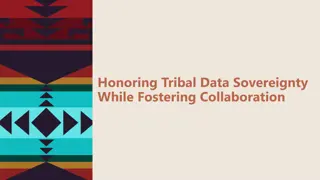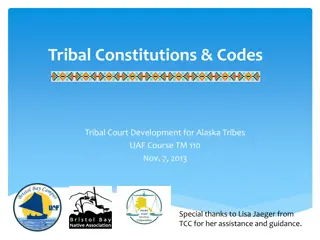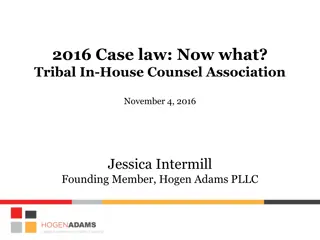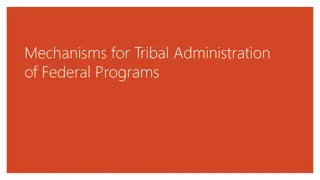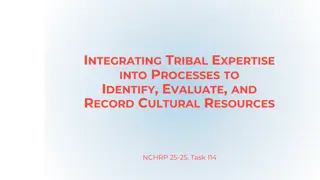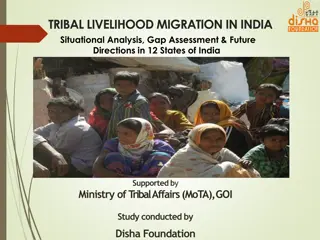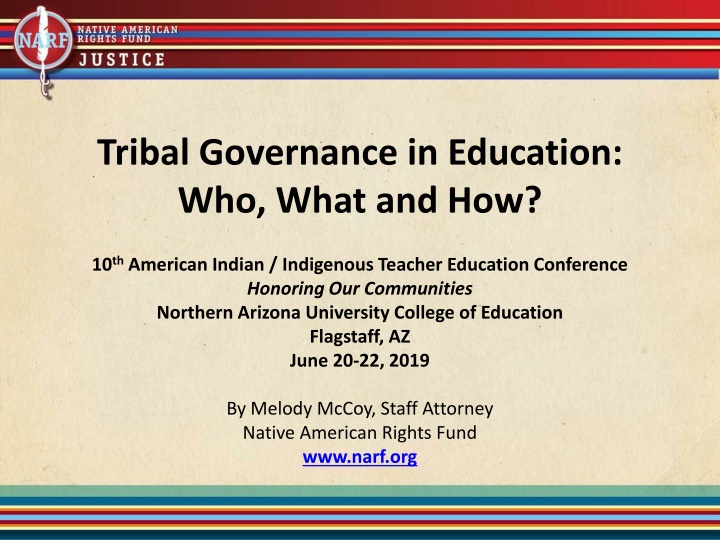
Tribal Governance in Education: Insights and Perspectives
Explore the dynamics of tribal governance in education, including the roles of federal, state, and tribal entities in fulfilling the educational needs of Native children. Discover the concept of sovereignty, education governance, and the diverse approaches to governing education.
Uploaded on | 1 Views
Download Presentation

Please find below an Image/Link to download the presentation.
The content on the website is provided AS IS for your information and personal use only. It may not be sold, licensed, or shared on other websites without obtaining consent from the author. If you encounter any issues during the download, it is possible that the publisher has removed the file from their server.
You are allowed to download the files provided on this website for personal or commercial use, subject to the condition that they are used lawfully. All files are the property of their respective owners.
The content on the website is provided AS IS for your information and personal use only. It may not be sold, licensed, or shared on other websites without obtaining consent from the author.
E N D
Presentation Transcript
Tribal Governance in Education: Who, What and How? 10th American Indian / Indigenous Teacher Education Conference Honoring Our Communities Northern Arizona University College of Education Flagstaff, AZ June 20-22, 2019 By Melody McCoy, Staff Attorney Native American Rights Fund www.narf.org
K-12 Native Student Population Total population of American Indians & Alaska Natives in United States today is about @ 3 million Total AI / AN K-12 student population nationwide is about @ 650,000 Only 1.2 % of K-12 students nationwide, but in 5 states, > 10%: Alaska, Oklahoma, Montana, New Mexico & South Dakota Over 90% AI /AN K-12 students attend state public schools; less than 10% attend BIE-funded schools http://www.ncai.org/about-tribes/demographics http://www.niea.org/our-story/history/information-on-native-students/ 1
3 Separate Sovereigns Federal State Tribal United States v. Bryant, 136 S.Ct. 1954 (2016) 2
What is a Sovereign ? Generally, an independent political community, whose members are bound together by being subjected to a central authority whose commands those members must obey Black s Law Dictionary (11th ed. 2019) 3
Share Education Governance The court concludes that all three governments federal, state and tribal each have a duty to educate Native children Meyers v. Board of Education of San Juan School District, (D. Utah 1995) 4
What is Education Governance ? Authority Requirements & procedures Administration & enforcement Goals & expectations 5
How is Education Governed ? Laws, regulations & policies Agencies, entities & officials Funding & resources Culture & traditions 6
Federal & State Governance US Constitution generally leaves public education to states 1965 Elementary & Secondary Education Act brings in federal requirements for resources Federal role in public education has grown 7
Historical Federal Indian Education Laws & Policies Treaty Era (1770s 1871) Nation-to-Nation negotiated legal contracts Education provisions In exchange for land & peace US often contracted with churches to fulfill Early 1800s education laws Some appropriations Passive-assimilationist 9
Historical Federal Indian Education Laws & Policies Allotment & Assimilation Era (1871-1934) Unilateral & active-assimilationist laws Education as a means to assimilate & destroy Federal Indian boarding schools Increase in state public school systems Extreme education laws Rations withheld for school non-attendance Unconsented Indian youth reform schools 10
Historical Federal Indian Education Laws & Policies New Deal Era (1920s & 1930s) By 1912 most Native kids are in public schools It was thought they would assimilate better 1928 Meriam Report 1934 Johnson O Malley Act In education, federal role reduced, state role increased & tribal role ignored 11
Historical Federal Indian Education Laws & Policies Termination Era (1940s & 1950s) Abolition or transfer of federal role for Indians Over 100 tribes lost gov t-to-gov t relations More federal Indian schools closed JOM & Impact Aid subsidized state public schools 12
Present Federal Indian Education Laws & Policies Self-Determination Era (1960s & 1970s) Many new federal programs recognized tribes 1963 Vocational Education Act 1965 Elementary & Secondary Education Act 1965 Head Start program 1966 Adult Education Act 1969 Kennedy Report recommended increased Indian control & increased role of tribes in education 13
Present Federal Indian Education Laws & Policies Self-Determination Era (1960s & 1970s) 1972 Indian Education Act Formula grant program (now ESSA Title VI) Office of Indian Education outside of BIA NACIE Nothing about tribal governance of education 14
Present Federal Indian Education Laws & Policies Self-Determination Era (1960s & 1970s) 1970 President Nixon Policy Sovereignty over tribal Indians is first & foremost with their tribal governments Federal government must support & strengthen tribal governments 15
Present Federal Indian Education Laws & Policies Self-Determination Era (1960s & 1970s) 1975 Self-Determination Act Title I allows tribes to contract programs & services formerly administered by federal gov t, including BIA schools Title II reformed JOM to prioritize contracts to tribes, increase state & LEA compliance, & provide for elected Indian parent committees 16
Present Federal Indian Education Laws & Policies Self-Determination Era (1960s & 1970s) 1978 ESEA Re-authorization Impact Aid IPPs require tribal participation BIA-funded schools to develop education standards in consultation with tribes 1978 Tribally Controlled Community College Act 17
Present Federal Indian Education Laws & Policies Self-Determination Era (1980s) 1984 ESEA Reauthorization 1st mention of Tribal Education Departments Tribes can use 638 funds for TEDs & Codes 1988 ESEA Reauthorization BIA-funded school actions require tribal consultation, & request or approval Authorization for direct funding for TEDs 18
Present Federal Indian Education Laws & Policies Self-Determination Era (1990s) 1991 Indian Nations at Risk Report Recommends state-tribal governmental partnerships in public school education 1994 ESEA Reauthorization Authorization for direct funding for TEDs through US Department of Education 19
Present Federal Indian Education Laws & Policies Self-Determination Era (2000s) 2001 ESEA Reauthorization (NCLB) Strengthened provisions for tribal accreditation of certain BIE-funded schools Retained both TED direct funding authorizations FY 2015 1st appropriations for TEDs 20
Present Federal Indian Education Laws & Policies Self-Determination Era (2000s) 2015 ESEA Reauthorization (ESSA) Requires states to consult with tribes for Title I funding Makes permanent State-Tribal Education Partnership grant program Requires LEAs to consult with tribes for all funding & specifically for Formula Grants Requires BIE to consult with tribes for Title VI 21
Present Federal Indian Education Laws & Policies 2015 ESSA Title I consultation requirement Current annual appropriations - for JOM @ < $4 million - for IEA Formula Grants @ $100 million - for Title I @ $16 billion 22
Present Federal Indian Education Laws & Policies 2015 ESSA Title I consultation requirement Most federal laws require federal agencies to consult with tribes Some federal laws have optional, voluntary state-tribal partnership arrangements No other federal law requires states to consult with tribes as a condition of getting federal $$ 23
What about State Laws ? In 1995, Wisconsin recognized TEDS in its American Indian Language and Culture Education Program Wis. Stat. 115.71 24
What about State Laws ? In 1999, Montana recognized TEDS in its Indian Education for All America Indian Studies Instruction provisions, including in-service training Mont. Code Ann. 20-1-502 25
What about State Laws ? In 2003, New Mexico recognized TEDs in its Indian Education Act, stating that one purpose of the Act is to ensure that TEDs are among those working to find ways to improve education for Indian students N.M. Stat. Ann. 22-23A-2 26
What about State Laws ? In 2010, Oklahoma s Advisory Council on Indian Education included representatives of TEDs Okla. Stat. tit. 70 3.173 27
What about State Laws ? In 2013, Washington became the 1st state to authorize state-tribal compacts in K-12 public school education Wash. Rev. Code 28A.715.005 28
What about State Laws ? In 2018, California became the 1st state to legislate consultation with tribes regarding Native studies curriculum Cal. Educ. Code 51226.9(a)(1) 29
What about State Laws ? At least 14 states have formalized roles for tribes in their school laws or administrative codes, most often in connection with state laws allowing the teaching of tribal native languages in schools, & the certification or licensing of teachers for the languages: Arizona, California, Idaho, Michigan, Minnesota, Montana, Nebraska, Nevada, New Mexico, North Dakota, Oregon, Washington, Wisconsin, & Wyoming 30
Tribal Education Governance Today Nationwide 573 federally-recognized tribes Less than have TEDs / TEAs Even fewer have Tribal Education Codes 31
Tribal Education Governance Today Washington State 5 Tribal Compact Schools: Suquamish Lummi Muckleshoot Quileute Nisqually http://www.k12.wa.us/IndianEd/STECs.aspx 32
Tribal Education Governance Today ESSA State-Tribal Education Partnership Program FY 2012 Grantees Oklahoma Chickasaw Nation New Mexico - Dine Idaho - Nez Perce Tribe Oregon Confederated Umatilla Tribes 33
Tribal Education Governance Today ESSA State-Tribal Education Partnership Program FY 2015 Grantees Oklahoma Muscogee Creek Nation Oklahoma - Chickasaw Nation Idaho - Nez Perce Tribe Idaho - Coeur d Alene Tribe FY 2019 applications due August 12, 2019 34
What Do All the Good Laws Really Mean? Troubling statistics In 2016, only about 75% of AI/AN students completed high school - less than any other racial or ethnic group in the US https://nces.ed.gov/pubs2019/2019038.pdf In 2015, about 50% of AI/AN K-12 students reported never being exposed to their Native languages, including in school https://nces.ed.gov/pubsearch/pubsinfo.asp?pubid=2019048 35
What Do All the Good Laws Really Mean ? Ongoing federal investigation U.S. Department of Education s Office of Civil Rights investigating alleged discrimination of Native students in Wolf Point School District, Montana (Ft. Peck Indian Reservation) Unequal treatment, push outs, discipline, harassment, retaliation, & deprivation of basic due process rights In 2010, 6 Native students committed suicide; another 20 attempted https://www.aclumontana.org/sites/default/files/field_documents/fort_peck_reservation_ title_vi_doj_complaint.pdf 36
What Do All the Good Laws Really Mean ? Pending federal court case (Stephen C., et al. v. BIE) Havasupai Elementary School (K-8) Allegations Failure to provide basic instruction Only minimal instruction in Native language Non-compliant library No extracurricular activities Disabled students ignored or mistreated 37
Can Tribes Govern State Public Schools? US Court of Appeals for the Ninth Circuit Possibly, where schools are on tribal land Window Rock Unified School Dist. v. Reeves, 861 F.3d 894 (9th Cir. 2017) US Court of Appeals for the Eighth Circuit Very unlikely Fort Yates Public School Dist. v. Murphy, 786 F.3d 662 (8th Cir. 2015) 38
Will the US ever Properly Manage Indian Education? US GAO, Further Actions on GAO Recommendations Needed to Address Systemic Management Challenges with Indian Education (April 2015) https://www.gao.gov/assets/670/669784.pdf US GAO, Further Actions Needed to Improve Oversight and Accountability for [BIE] School Safety Inspections (May 2017) https://www.gao.gov/products/GAO-17-421 39
What Can be Done about Attendance & Language? US GAO, Public School Choice: Limited Options Available for Many AI/AN Students (January 2019) https://www.gao.gov/assets/670/669784.pdf In 2015, Oklahoma became the 1st state to authorize tribes to charter directly state public schools Okla. Stat. tit. 70 3-132 40

